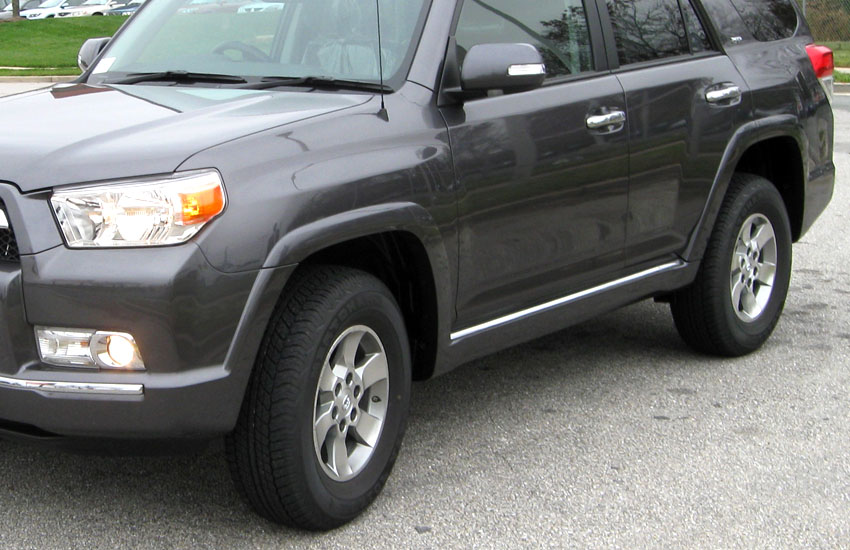As an Amazon Associate, I earn from qualifying purchases at no extra cost to you.
What’s the Lug Nut Torque for a Toyota 4Runner?
If you own a Toyota 4Runner or are thinking about getting one, you've probably heard about lug nut torque specs. But, do you know what that really means for your vehicle? Understanding the correct lug nut torque is essential for keeping your 4Runner safe, running smoothly, and even enhancing your overall driving experience. In this article, we're diving into everything you need to know about Toyota 4Runner lug nut torque specs, why they matter, and how to make sure you’re getting them right.
Whether you’re a new 4Runner owner or an experienced car enthusiast, this guide will give you the confidence to tackle tire changes, maintenance, and more. Ready to learn? Let's jump in!

Understanding Lug Nut Torque: Why It Matters for Your Toyota 4Runner
When it comes to your Toyota 4Runner, lug nuts are the unsung heroes holding your wheels securely in place. But did you know that the way you tighten these lug nuts is just as important as the tire itself? Getting the right torque is key to ensuring your wheels stay safely fastened while driving.
What is Torque and Why is it Important?
Torque is the force that's applied to rotate the lug nut and secure your wheel. Each vehicle, including the Toyota 4Runner, has a specific torque requirement. This number is critical because if the lug nuts are too loose, your wheel could come off while driving, which is incredibly dangerous. On the other hand, if you tighten them too much, you risk damaging the wheel, the lug nut, or even the brake components.
How Tight Should You Go?
For your Toyota 4Runner, the recommended lug nut torque usually falls between 80 and 100 foot-pounds. However, this can vary based on the model year and whether you have aftermarket wheels or components installed. It's important to follow the manufacturer's specifications to avoid potential issues down the road.
Effects of Incorrect Torque
Both under-torquing and over-torquing can cause serious damage. If you don’t apply enough torque, the wheel could wobble or even detach while driving, leading to a loss of control. Over-torquing, on the other hand, can warp the wheel or break the lug nuts. It's all about finding that perfect balance, and in this section, we'll show you how to do just that!
How to Properly Torque Your Toyota 4Runner’s Lug Nuts
Now that you understand the importance of correct torque, it's time to learn how to do it properly. In this section, we'll walk you through the steps to safely and effectively torque your Toyota 4Runner's lug nuts, ensuring a secure fit every time.
Step 1: Gather the Right Tools
To begin, you'll need a few key tools to perform this task safely and accurately:
- A torque wrench: This is the most important tool for the job, allowing you to measure the exact amount of torque you're applying.
- A lug wrench: This will help you remove the lug nuts before re-tightening them.
- A jack and jack stands: You'll need to lift the vehicle off the ground before working on the lug nuts.
- A tire iron or breaker bar: These tools come in handy for loosening the lug nuts if they’re too tight.
Make sure your tools are in good condition and ready to use. If you're unsure about any of these tools, visit your local auto parts store for advice.
Step 2: Lift the 4Runner
Before you can torque the lug nuts, you need to lift your 4Runner so the wheels are off the ground. Place the jack under the vehicle's jacking point and lift it high enough so the tires no longer touch the ground. Make sure to use jack stands for extra safety. Never attempt to work under a car that is only supported by a jack.
Step 3: Loosen the Lug Nuts
Once the vehicle is safely lifted, use a lug wrench to loosen (but not completely remove) the lug nuts on your 4Runner. Start with the first lug nut, then move to the opposite side of the wheel and continue loosening in a criss-cross pattern. This ensures the even distribution of force when you tighten them later.
Step 4: Torque the Lug Nuts
Now comes the important part: tightening the lug nuts. Set your torque wrench to the recommended value for your Toyota 4Runner. As mentioned earlier, this is typically between 80 and 100 foot-pounds. Start tightening the lug nuts in a criss-cross pattern to ensure even pressure on the wheel. This will help prevent any warping or stress on the components.
Remember to always double-check the torque setting after you've completed the tightening process.
Step 5: Double Check Your Work
Once you've torqued all the lug nuts, it's crucial to double-check them. A few minutes spent verifying that each lug nut is properly tightened can save you from future headaches. You can either use your torque wrench to check the tension on each nut or simply perform the "wiggle test" to see if any of the lug nuts feel loose.
Step 6: Lower the Vehicle and Test Drive
Now that the lug nuts are securely in place, carefully lower the vehicle back down to the ground. Make sure the tires are firmly on the surface before you drive. Take your 4Runner for a short drive, and when you're done, recheck the lug nut torque to make sure everything is still tight and secure.
Also Read: What’s the Recommended Gap Between a Torque Converter and Flexplate? A Complete Guide for Beginners
Common Mistakes to Avoid When Torquing Your 4Runner's Lug Nuts
While torquing your Toyota 4Runner's lug nuts may seem straightforward, there are a few common mistakes that many people make. In this section, we'll highlight these mistakes and show you how to avoid them, ensuring your wheels stay safe and secure.
Mistake #1: Using the Wrong Tools
One of the biggest mistakes people make when working on their 4Runner's wheels is using improper tools. For example, using a regular wrench instead of a torque wrench could lead to under-tightening or over-tightening the lug nuts, which can cause damage to your vehicle. Always use the right tools for the job.
Mistake #2: Skipping the Torque Specs
Another common mistake is not following the manufacturer's recommended torque specifications. Every vehicle is different, and each has its own specific requirements for lug nut torque. Skipping this step can lead to dangerous situations, like loose wheels or damaged parts.
Mistake #3: Tightening the Lug Nuts in the Wrong Pattern
When tightening lug nuts, it's essential to follow the correct criss-cross pattern. Many people make the mistake of tightening the nuts in a circular pattern, which can cause uneven pressure on the wheel and lead to damage. Always follow the recommended pattern for your Toyota 4Runner.
Mistake #4: Over-Tightening
It's easy to think that the tighter the better, but over-tightening your lug nuts can cause significant damage. If you apply too much torque, you risk breaking the lug nuts, warping the wheel, or damaging the brake components. Stick to the recommended torque specs and avoid going overboard.
Mistake #5: Forgetting to Check After Driving
After torquing the lug nuts and driving your 4Runner, it's important to check the lug nuts again. Heat and vibration from driving can cause them to loosen over time. Make it a habit to check your lug nut torque after short drives to ensure they're still tight.
What Happens if You Don't Get the Lug Nut Torque Right?
If you fail to tighten your Toyota 4Runner's lug nuts correctly, it can lead to several issues, some of which may be serious. Let's take a closer look at what could go wrong.
Wheel Detachment
The most dangerous consequence of improperly torqued lug nuts is the possibility of the wheel coming off while you're driving. If the lug nuts are too loose, there's nothing holding the wheel securely in place. This could cause the wheel to detach from the vehicle, leading to a catastrophic accident.
Uneven Tire Wear
Incorrect lug nut torque can cause uneven pressure on the tire and wheel, leading to premature tire wear. When the lug nuts are too tight in certain spots, they can distort the shape of the tire, causing it to wear unevenly. This not only reduces the lifespan of your tires but can also affect the performance and handling of your 4Runner.
Brake and Suspension Damage
Over-tightening the lug nuts could result in damage to the brake and suspension components. Excessive torque can put too much pressure on the brake rotor, making it difficult for the braking system to function properly. Over time, this can cause brake issues and lead to costly repairs.
Warped Wheels
If you apply too much torque, you risk warping the wheel itself. This can lead to a variety of problems, including vibrations while driving, reduced stability, and an overall unpleasant driving experience.
Frequently Asked Questions
Is it safe to torque the lug nuts without a torque wrench?
It's not recommended. A torque wrench ensures you're tightening the lug nuts to the correct specification, preventing over-tightening or under-tightening.
Can I use an impact wrench to tighten the lug nuts?
While an impact wrench can be used to remove lug nuts, it's not recommended for tightening them. Always use a torque wrench to ensure proper torque.
Do I need to torque the lug nuts in a specific order?
Yes, you should torque the lug nuts in a criss-cross pattern to ensure even pressure and prevent damaging the wheel or brake components.
Is it okay to recheck the lug nut torque after driving?
Yes, it's a good idea to recheck the lug nuts after a short drive to make sure they remain tight.
Is it necessary to replace lug nuts after a certain time?
If the lug nuts are damaged or corroded, they should be replaced. Over time, they can wear down and become less effective at holding the wheel in place.
Can the lug nut torque specs vary by model year?
Yes, the torque specs can vary slightly depending on the year and model of your Toyota 4Runner. Always refer to your vehicle's manual for the correct specifications.
Do I need to use anti-seize on the threads?
It's not usually necessary to use anti-seize on the threads of the lug nuts, but some people choose to do so to prevent rust and corrosion.
Is it dangerous to drive with loose lug nuts?
Yes, driving with loose lug nuts is extremely dangerous. It could lead to the wheel detaching while driving, which can result in a serious accident.
I hope this guide has helped you understand the importance of correct lug nut torque for your Toyota 4Runner. It's a small but crucial task that can keep your vehicle running smoothly and safely. Make sure to always follow the manufacturer's recommended specs, use the right tools, and double-check your work to avoid any issues down the road.


